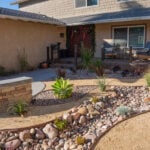An all-encompassing method for converting outside areas into aesthetically beautiful and useful settings is landscaping. Hardscaping is a vital component of landscaping that gives the whole design more structure, form, and permanency. Hardscaping is the study of a landscape’s non-living components that support its architectural and design elements. This is in contrast to softscaping, which uses living elements like plants and trees. We will go into the definition, elements, design concepts, and many advantages that hardscaping offers to outdoor environments in this post.
Defining Hardscaping
In essence, hardscaping is the incorporation of inanimate objects into landscape design to create a strong base and structure for the entire outdoor space. This can incorporate a variety of elements, such as pergolas, fountains, and ornamental stones, in addition to patios, pathways, and retaining walls. Hardscaping is primarily used to improve outdoor spaces’ use and aesthetic appeal while achieving a harmonious balance between the natural world and the built environment.
Key Components
Patios and Decks:
Patios and decks are popular hardscaping elements that serve as outdoor living spaces. Constructed with materials such as concrete, pavers, or wood, these areas provide a comfortable and inviting space for socializing, dining, and relaxation.
Walkways and Pathways:
Hardscaped walkways and pathways guide the flow of movement throughout the landscape. These can be made from materials like gravel, bricks, or natural stones, creating a functional and visually appealing connection between different areas of the outdoor space.
Retaining Walls:
Retaining walls serve both aesthetic and functional purposes. They can be used to level sloped areas, prevent soil erosion, and create distinctive tiers in the landscape. Materials like stone, concrete, or timber can be employed to construct retaining walls.
Water Features:
Fountains, ponds, and waterfalls are hardscaping elements that add a touch of tranquility to outdoor spaces. Water features not only enhance the visual appeal but also introduce soothing sounds, creating a more immersive and relaxing environment.
Outdoor Structures:
Structures like pergolas, arbors, and gazebos are hardscape features that provide shelter, define spaces, and add vertical interest to the landscape. These elements can be crafted from various materials, allowing for customization to suit the overall design theme.
Decorative Elements:
Decorative elements, such as sculptures, statues, and ornamental planters, contribute to the artistic aspect of hardscaping. These features can be strategically placed to serve as focal points or accentuate specific areas within the landscape.
Principles in Hardscaping
Unity and Harmony:
A well-designed hardscape integrates seamlessly with the natural surroundings, creating a unified and harmonious outdoor space. Consistency in materials, colors, and shapes helps achieve a cohesive look.
Balance:
Achieving balance is crucial in hardscaping to distribute visual weight evenly throughout the landscape. This involves considering the placement of elements, their sizes, and the overall symmetry or asymmetry of the design.
Scale and Proportion:
Proper scale and proportion are essential to ensure that hardscape elements relate well to each other and to the overall size of the outdoor space. Oversized or undersized features can disrupt the visual balance of the landscape.
Contrast:
Introducing contrast in hardscape design adds visual interest. This can be achieved through variations in color, texture, or material. Contrasting elements highlight specific features and create a dynamic landscape.
Functionality:
Hardscaping should not only be visually appealing but also practical. Consider the functionality of each element, ensuring that it enhances the usability and enjoyment of the outdoor space.
Benefits of Hardscaping
Low Maintenance:
Unlike softscaping elements that require ongoing care, hardscape features are generally low-maintenance. Materials such as stone, concrete, and pavers are durable and resistant to weather, reducing the need for constant upkeep.
Extended Living Space:
Well-designed hardscapes extend the usable living space outdoors. Moreover, patios, decks, and other features create areas for entertaining, dining, and relaxation, allowing homeowners to make the most of their outdoor environments.
Erosion Control:
Retaining walls and other hardscape elements can help control soil erosion on sloped landscapes. Therefore, this is crucial for maintaining the integrity of the outdoor space and preventing damage to surrounding vegetation.
Increased Property Value:
Thoughtfully designed hardscaping adds curb appeal and can significantly increase the overall value of a property. Potential buyers often appreciate well-planned outdoor spaces that require minimal maintenance.
Water Conservation:
Hardscaping can contribute to water conservation by reducing the need for extensive lawns and other water-dependent softscape features. Therefore, using permeable materials for pathways allows water to seep into the ground, promoting natural drainage.
Transformative Force
In conclusion, hardscaping is an integral aspect of landscaping that focuses on incorporating non-living elements to enhance the structure and design of outdoor spaces. From patios and walkways to water features and decorative elements, hardscaping offers a myriad of possibilities for creating aesthetically pleasing and functional landscapes. By adhering to design principles such as unity, balance, and proportion, and considering the numerous benefits it brings, hardscaping becomes a transformative force in turning outdoor areas into inviting and enduring environments. Whether for residential or commercial spaces, the art of hardscaping continues to evolve, shaping the way we experience and appreciate the beauty of our outdoor surroundings.






